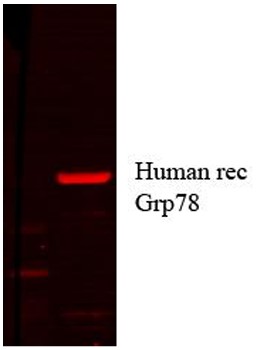Anti-GRP78 Antibody (11134)
Anti-GRP78 Antibody (11134)
Product No.: 11134
- -
- -
Clone 1H11-1H7 Target GRP78 Formats AvailableView All Product Type Monoclonal Alternate Names EC 3.6.4.10, 78 kDa glucose-regulated protein, GRP-78, Binding-immunoglobulin protein, BiP, Heat shock protein 70 family protein 5, HSP70 family protein 5, Heat shock protein family A member 5, Immunoglobulin heavy chain-binding protein Isotype Mouse IgG2b Applications ELISA , WB |
Data
- -
- -
Antibody DetailsProduct DetailsReactive Species Bovine ⋅ Fungal ⋅ Hamster ⋅ Human ⋅ Monkey ⋅ Mouse ⋅ Rabbit ⋅ Rat ⋅ Xenopus Host Species Mouse Immunogen His-tagged human GRP78 (accession no. NP_001156906.1) Product Concentration Lot Specific Formulation PBS, pH 7.4, 0.09% sodium azide. State of Matter Liquid Product Preparation Purified by Protein G affinity chromatography Storage and Handling This antibody is stable for at least one (1) year at -20°C. Avoid repeated freeze-thaw cycles. Regulatory Status Research Use Only Country of Origin USA Shipping Next Day 2-8°C Applications and Recommended Usage? Quality Tested by Leinco Immunoblotting: use at 0.5-1.0ug/ml. A band of ~78kDa is detected. Positive control: HeLa cell lysate. Each investigator should determine their own optimal working dilution for specific applications. See directions on lot specific datasheets, as information may periodically change. DescriptionDescriptionSpecificity This antibody recognizes human GRP78. Background GRP78 is a ubiquitously expressed, 78kDa glucose-regulated protein commonly referred to as an immunoglobulin chain binding protein (BiP). Categorized as stress response proteins, BiPs play an important role in folding and assembly of nascent proteins and in scavenging of misfolded proteins in the endoplasmic reticulum lumen. Translation of BiP is directed by an internal ribosomal entry site (IRES) in the 5- nontranslated region of BiP mRNA. BiP IRES activity increases when cells are heat-stressed. GRP78 is also important in maintenance of cell homeostasis and the prevention of apoptosis. Levels of GRP78 protein are reduced in brains of Alzheimer's disease patients. Function Endoplasmic reticulum chaperone that plays a key role in protein folding and quality control in the endoplasmic reticulum lumen (PubMed:12411443, PubMed:12475965). Involved in the correct folding of proteins and degradation of misfolded proteins via its interaction with DNAJC10/ERdj5, probably to facilitate the release of DNAJC10/ERdj5 from its substrate (PubMed:12411443). Acts as a key repressor of the ERN1/IRE1-mediated unfolded protein response (UPR) (By similarity). In the unstressed endoplasmic reticulum, recruited by DNAJB9/ERdj4 to the luminal region of ERN1/IRE1, leading to disrupt the dimerization of ERN1/IRE1, thereby inactivating ERN1/IRE1 (By similarity). Accumulation of misfolded protein in the endoplasmic reticulum causes release of HSPA5/BiP from ERN1/IRE1, allowing homodimerization and subsequent activation of ERN1/IRE1 (By similarity). Plays an auxiliary role in post-translational transport of small presecretory proteins across endoplasmic reticulum (ER). May function as an allosteric modulator for SEC61 channel-forming translocon complex, likely cooperating with SEC62 to enable the productive insertion of these precursors into SEC61 channel. Appears to specifically regulate translocation of precursors having inhibitory residues in their mature region that weaken channel gating. May also play a role in apoptosis and cell proliferation (By similarity). {UniProtKB:G3I8R9, UniProtKB:P11021, PubMed:12411443, PubMed:12475965}. NCBI Gene Bank ID UniProt.org Research Area Heat Shock & Stress Proteins References & CitationsTechnical ProtocolsCertificate of Analysis |
Formats Available
 Products are for research use only. Not for use in diagnostic or therapeutic procedures.
Products are for research use only. Not for use in diagnostic or therapeutic procedures.



